1503 17th Street Northwest
Washington, DC 20036
(202) 462-8999
Despite having been open for 26 years and being one of DC's oldest sushi restaurants, Sushi Taro somehow manages to fly under the radar. It baffled me that a restaurant considered among DC's best for sushi with such longevity wasn't an institution in the DC area. What I'd failed to take into account was that the current Sushi Taro only came about a few years earlier.
The restaurant is currently run by Jin and Nobu Yamazaki, but it was started by their father. Jin typically handles the business end of things while Nobu is responsible for developing the menu. In its original incarnation, the restaurant was more of a neighborhood sushi spot, offering the typical slate of Americanized rolls as well as sushi. In late 2008 Nobu and Jin made the decision to change the restaurant's strategy and offer more traditional Japanese cooking; as Nobu put it "changing the direction of Japanese cooking in this city." To that end, they closed the restaurant, redecorated the dining room, remodeled the kitchen, and introduced a new kaiseki menu format.
In addition to the regular menu, Sushi Taro offers a special Omakase counter that requires reservations at least 48 hours in advance. The counter is hidden in the back corner of the restaurant and the tiny room seats up to six, though the chefs typically prefer to serve no more than four people a night. Guests at the bar are treated to seasonal delights served by Nobu and the restaurant's CdC Masa Kitayama. To some extent, the bar is as much for them as it is for us, giving them a forum where they can practice their craft unfettered by mundane concerns like commercial viability.

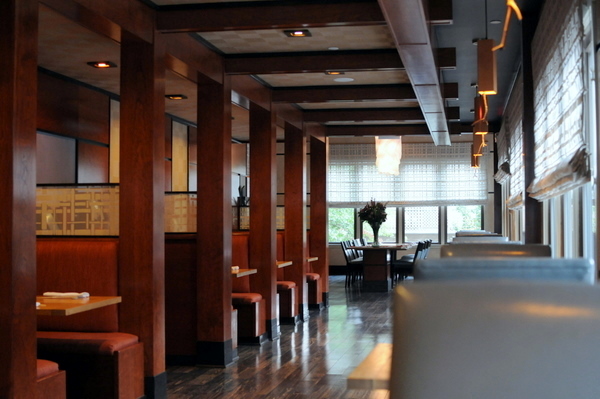
Goma Tofu - Sesame Paste, Wasabi
The regular kaiseki starts with this course as well, but this preparation has a much more nuanced flavor thanks to the a short stint over a charcoal grill. The tofu develops a firm smoky skin around the tender jellied interior, quite nice with the bracing spice of the wasabi.

Kaiawase - Orange Clam, Scallion, Mustard Jelly, Miso, Lily Bulb, Turnip, Mustard Greens, Burdock, Miso Soil
Kaiseki meals are heavily dependent on the season and this course was inspired by the Hinamatsuri, the Japanese Doll Festival which takes place on March 3. To that end the course is named Kai-awase after a clam shell-matching game played during the festival. The two shells feature very different ingredients that all compliment one another very well and we were told to alternate between bites to get the full experience. The left clam shell contains two pieces of swimmingly fresh orange clam with a bright mustard jelly and fresh scallion. The other contains a verdant mix of spring vegetables with some sweetness from the miso soil.

Tuna Spinal Jelly
This was my second experience with Tuna spinal fluid. The jelly carries just a hint of clean brine while the ikura and uni add their own styles of salinity augmenting the delicate flavor of the jelly. I would have preferred they clean the bones a bit more thoroughly as the gristle was a bit disconcerting, but the the flavor was pure bliss.

Hirame Usuzukuri - Engawa, Liver, Ponzu
Next up was a presentation of thinly sliced flounder that had been freshly killed that morning. The delicate pieces of translucent flesh are snappy and mild making the ponzu a must. The liver reminded me of ankimo with the same livery tang but not quite rich. Lastly the Engawa was a special treat, despite a muscular texture the abductor also exhibited a spectacular oiliness comparable to toro.

Hassun
I've had entire meals that didn't have as many ingredients as this single plate. Hassun is a staple of Kaiseki meals; the dish consists of numerous smaller elements and is typically used to set the seasonal theme. Rather than describe everything on the plate I'll focus on a couple highlights. The octopus with its deep brine and dense tender texture was my clear favorite. I quite enjoyed the whelk as well, dense toothsome and savory without too much of the earthy funk typical of conch or whelk. The butterbur blossom tempura was another star, its verdant sapor tempering its companion, a tiny cuboid of fish cake and king crab.

At this point we were presented a serving platter and two types of soy one traditional to be mixed with wasabi and the other filled with grated ginger. The chefs retrieved six black lacquer display boxes and proceeded to explain the night's fish selection. We were then given the option of selecting our own sashimi courses or trusting the chefs to select the best pieces. Naturally given the nature of the meal I went for the second option.
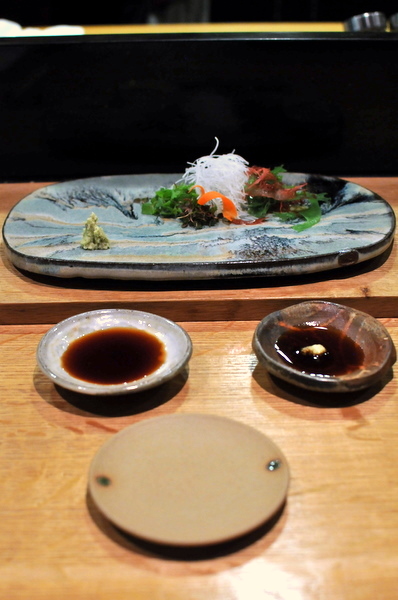
Tray 1: Tako, Anago, Unagi, Tamago, Ebi
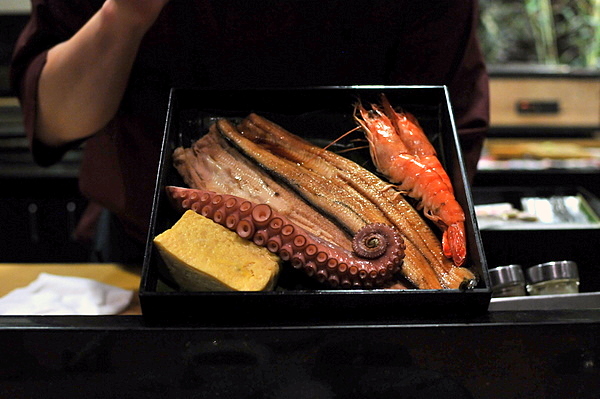
Tray 2: Saba, Aji, Sayuri, Himechi, Tachi-uo
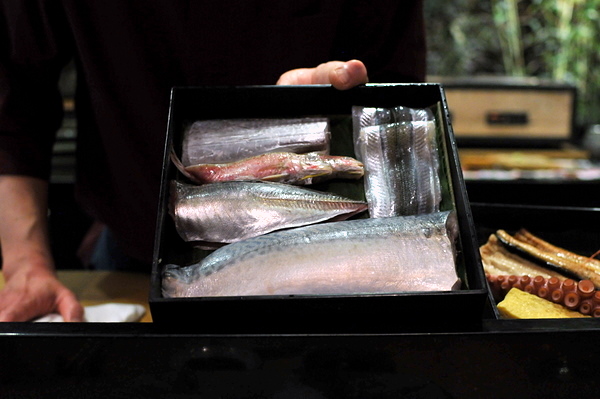
Tray 3: Maguro, Chu-Toro, Toro, Kama
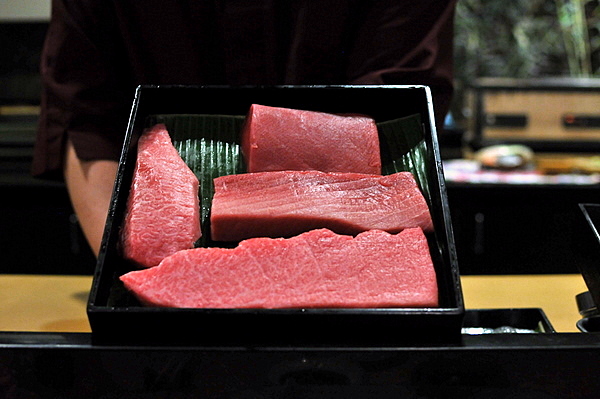
Tray 4: Sakuramasu, Bonito, Buri
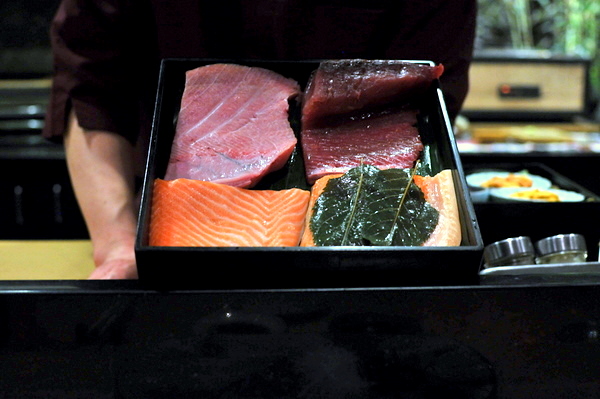
Tray 5: Uni (Santa Barbara), Uni (Maine), Ikura, Hamaguri, Aori Ika
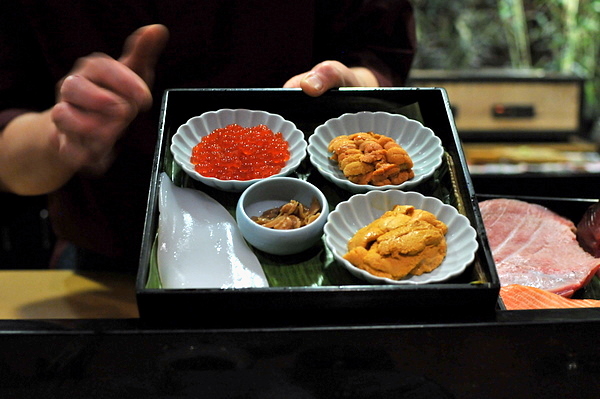
Tray 6: Madai, Suzuki, Houbou, Isaki, Kisu
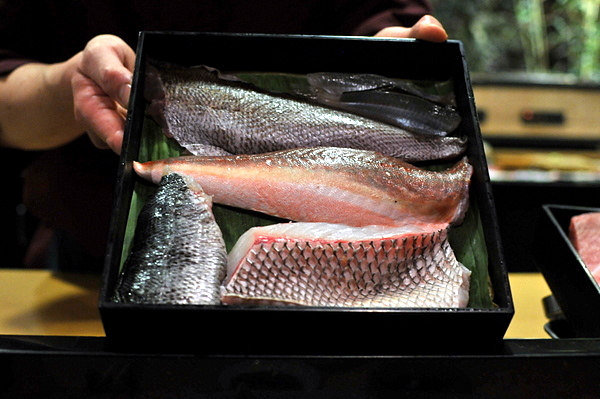
Kisu - Silver Whiting
This was a new fish for me, the mild supple flesh lends itself well to salinity of the kobujime or kelp marinade.

Sayuri - Needlefish
Another delicate white fish, the sayuri came classically prepared with a sliver of fragrant Japanese mint. Nobu recommended using the ginger soy which gave the fish a bit of spice.

Sakuramasu - Cured Arctic Char
A close relative of salmon, the char has a similar buttery richness. I've had Arctic Char a number of times before but the cure really added an unexpected woody character to the aggressive flavor of the yukishio (snow salt)

Hotate - Scallop
The scallop came topped with a generous dusting of yuzu zest and fleur de sel. The citrus is intense on the nose and lends the shellfish a wonderful fruity interplay with the salt.

Chu-Toro - Medium Fatty Tuna
This piece of Chu-toro exhibits touches of both the clean flavor of maguro and the richness of toro. The fish turns slightly creamy upon mastication while the oiliness grows and lingers on the palate.

Buri - Wild Yellowtail
Buri tends to exhibit more seasonal variety then typical farm raised yellowtail. Though the fish is rightly prized for its oiliness, this was a firmer leaner presentation more sweet than fat. The sashimi came with an added surprise a piece of toro charred over the grill adding a wicked smokiness to the already delicious belly fat.

Aji Namerou - Spanish Mackerel Tartare
Nobu mentioned that Namerou is a common fisherman's meal in Japan. The minced fish is mixed with ginger, plum, shiso, and miso the hearty blend of sweet savory and aromatic is compelling especially when served with a fish robust enough to still stand out regardless.

Toro - Fatty Tuna
No sashimi course would be complete without the unbridled richness of fatty tuna. Tender and perfectly clean of tendon or gristle just pure lusciousness.

Kama Toro - Tuna Cheek
If you can believe it Kama Toro is even rarer and more expensive than regular toro. The meat has a starker marbling pattern, more like a cut of prime beef than tuna. Despite having the brazen fattiness of toro, the texture is noticably denser and firmer. I appreciated the light sear on the tuna but could have done without the garlic chips to better appreciate the unadulterated flavor of the cheek.

Zuppon - Soft Shell Snapping Turtle, Turtle Egg, Scallion, Ginger
Nobu likened this to a seafood consomme and he couldn't have been more spot on. The turtle gives the soup a delicate yet clear note of salinity. The ginger and scallion add classic complimentary flavor but the real treat here are the lightly poached egg yolks and the lovely thickness they add to the clear broth.

Waka-take-ni
This is a popular springtime dish pairing fresh bamboo shoots with wakame seaweed. Another graceful course, the light snap of the bamboo and seaweed are enriched with a touch of dashi. A generous shaving of bonito gives the dish a lingering woody backbone. Nobu actually took out a piece of solid bonito to show and after aging for several years, it looked more like a piece of wood than fish.
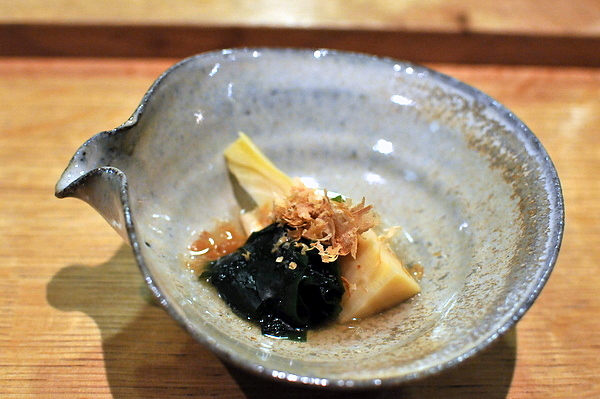
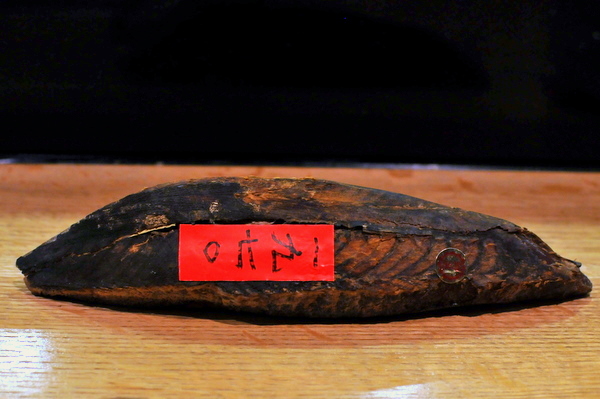
Fugu - Puffer Fish
Coincidentally enough, right before Nobu presented this course I asked if he was licensed to serve fugu. He said that he wasn't but proceeded to present me with two generous pieces of the fish which naturally worried me a bit. Seeing my dubious expression, Nobu let me in on a little secret: any fugu exported to the US has to have the poison is removed so there was no real risk of me dying much as some of you may have hoped. Puffer fish tends to be a bit tough so it either has to be sliced very thin or seared to soften the meat. Nobu opted for the second presentation and the resulting texture was quite unique, still some firmness but also a slightly spongy give.
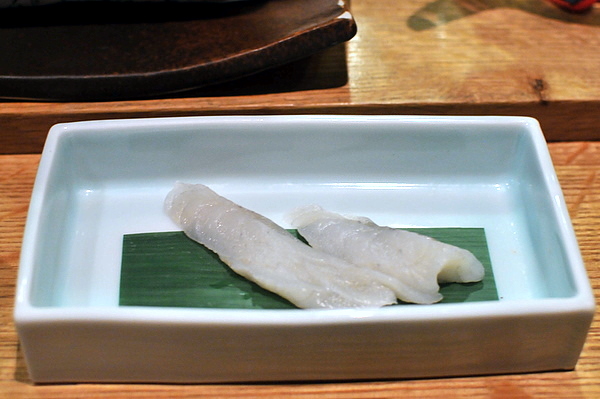
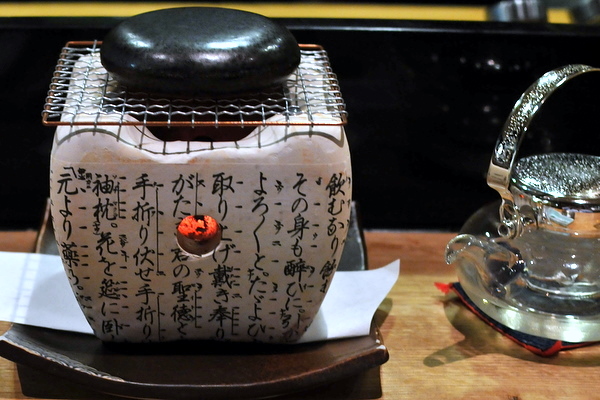
Bachiko - Sea Cucumber Roe
Apparently this is exceedingly rare even in Japan. Nobu described it as a "seafood beef jerky" and that's almost exactly what it was. The roe had a fibrous texture very similar to jerky with a concentrated earthy umami flavor that grew with every sliver of the precious roe that I ate.

Namako - Vinegar
I've eaten sea cucumber more times than I can count but I've never experienced something with this kind of texture. Sea cucumber typically has a slimy texture but this was so dense that I could feel the muscles in my jaw strain with the effort to chew it. After being lightly poached in tea, the cucumber was dropped in a vinegar sauce giving a palpable pungency to the earthy flavor of the sea cucumber.

Fugu Shirako
If you told me a few years ago that I would have preference for different types of fish sperm I probably would have punched you but this was far and away the best shirako that I've ever had. Biting through the exterior membrane releases a creamy slightly salty fluid that is inexplicably delicious.
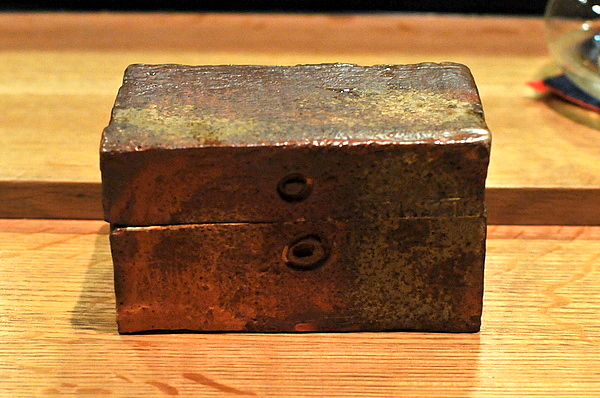
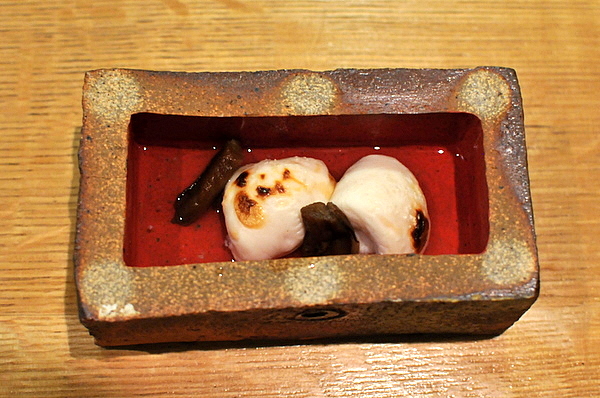
Crystal Crab
This might be my first experience with crystal crab, a deep water species found off the Australian coast known for its sweet flesh and rich mustard. Less is more with this course, the interplay with the briny mustard and ambrosial meat is a thing of sheer beauty.
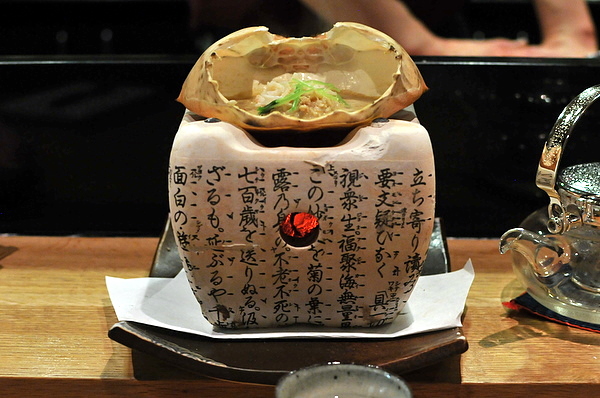
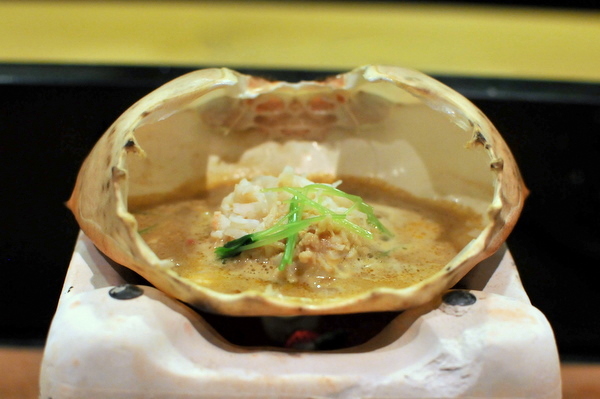
This ended the Kaiseki portion of the meal and with the switch to nigiri, we were again given the option to order or simply leave it up to the chef.
Madai - Snapper
Nobu explained that Madai is important in Japanese cuisine and traditionally served at celebrations. The fish was characteristically firm and came seasoned with salt and Japanese citrus.

Tachi-uo - Belt Fish
This was my first experience with belt fish nigiri. Nobu explained that this fish is best in summer and prepared this particular piece seared with the skin side down. The fish is surprisingly dense while the sear gives the otherwise delicate flesh some flavor.

Himeji - Red Mullet
Another first both the type of fish and the presentation. According to Nobu, this preparation and fish is a regional delicacy in south Japan. The fish is pickled giving it a nice tangy smack to go along with a sleek and tender texture.

Uni - Sea Urchin (Santa Barbara)
Nobu said he felt a bit odd serving me Uni from Santa Barbara figuring the quality would always be better local but this was pretty damn good; the perfect combination of salty and sweet

Bonito
Tasting this fish it was hard to identify it as bonito. Apparently bonito leans down significantly during Spring and that came through on the flavor.

Ebi - Madagascar Shrimp
I don't normally enjoy cooked shrimp nigiri but this was pretty tasty. The larger Madagascar shrimp retains some of the snap of a raw shrimp while the flavor was more intense and reminiscent of lobster.

Anago - Sea Eel
The anago looked almost fuzzy and the delicate fibers of the eel almost dissolve on the palate. Rather than the typical eel sauce Nobu opted for a lighter touch with yuzu and Okinawan salt making the eel's caramelized sapor quite apparent.

Saba - Mackrel
While the fish was a touch firmer than normal, the flavor was pure fish oil goodness.

Aori Ika - Cuttlefish
Besides being a touch softer, I had a hard time telling the difference between this and regular squid. The light flavor of the squid is accompanied by salt and kabosu, a bigger less tart cousin of yuzu.

Zuke - Marinated Tuna
I can't believe I made it this far into the meal without having a single piece of maguro. The fish already came infused with soy and was a touch smoother and drier than unseasoned tuna.

Toro - Fatty Tuna
Another immaculate and rich piece of luxury, despite wanting to try more unique goodies, its hard to say no to toro.

Hamaguri - Top Neck Clams
I don't recall having this as sushi before, the topnecks are lightly cooked but you couldn't tell from the snap. The flavor had a slightly bitter brackish cast to it

Unagi - Freshwater Eel
A stupendously rich example of unagi, the sweetness of the sauce is balanced by a numbing tingle from the sansho pepper.

Houbou - Blue Fin Robin
I've not seen this fish served at too many restaurants. The fish feels delightfully firm and has a flavor somewhere between snapper and yellowtail.

Maguro Kama - Tuna Cheek
The tuna cheek also makes an encore appearance in nigiri form. More thoroughly cooked this time, the melted fat gave the meat a slight gumminess as well as an even more potent richness. Again I would have preferred a lighter touch on the accompaniments. Such a rare treat deserves to shine on its own.

At this point Nobu asked if there was anything more that I wanted and I decided to end with Ikura and the Uni from Maine.
Ikura - Salmon Roe
The gunkan roll came topped with a generous helping of beautiful amber globules that release a rush of chilled smoky brine upon bursting.

Uni - Sea Urchin (Maine)
I initially thought this was Hokkaido uni but Nobu corrected me saying it was from Maine. The flavor is similar to its Japanese cousin with a stronger brine SB Uni.

Hoji-cha - Roasted Green Tea
Hoji-cha is often served after meals to aid in digestion and after 39 courses I needed the help. Despite its bitterness, hoji-cha is actually milder because roasting reduces the caffeine content of the tea.

Hoji-cha PuddingRoasted Green Tea Cream Pudding w/ Dark Caramel
Desserts at Asian restaurants are so often afterthoughts but Sushi Taro has a number of more elaborate offerings. Unable to decide, I asked Nobu to go ahead and pick his favorite. He went with an exquisitely smooth hoji-cha pudding tempered with a sugary caramel sauce. I love tea desserts and this was no exception.

Kuro-Goma IceRoasted Black Sesame Ice Cream
I mentioned my fondness for sesame ice cream so Nobu generously provided me with a small taste to cleanse my palate.

At the end of the night Chef/Owner Nobu Yamazaki (left) and chef de cuisine Masa Kitayama (right) posed for a quick photo. Nobu's comment about changing Japanese cuisine in DC struck me as a bit presumptuous but after experiencing this meal it is clear that the young duo have the talent and drive to do just that.
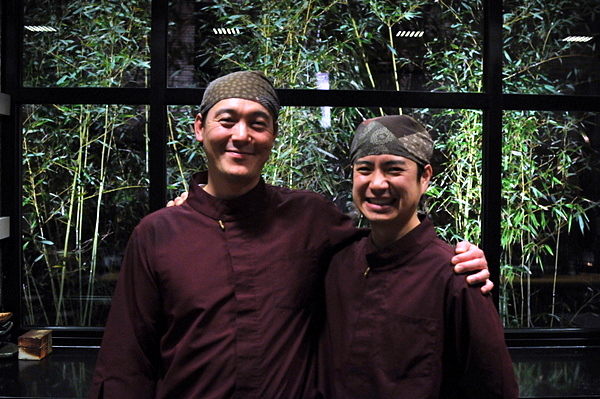
I had the Kaiseki Tasting and Sushi Tasting during one of my previous trips to DC and found the food to be quite good. The structure of the omakase counter is reminiscent but the personal attention of Nobu and Masa make the experience vastly superior. Though its pricey, Sushi Taro's Omakase Counter is without a doubt the best sushi in DC. If you love sushi you owe it to yourself to try this.
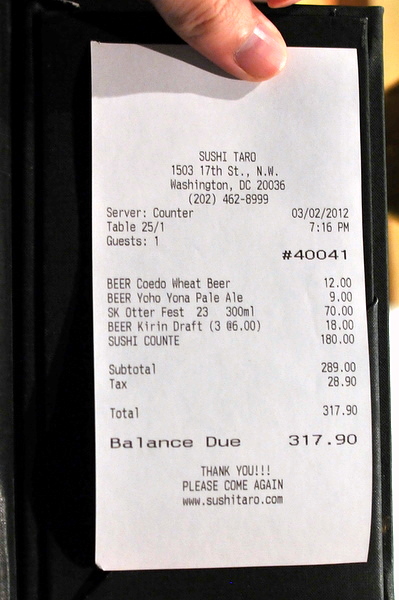
Monday, March 19, 2012
Sushi Taro - 03/02/2012
Subscribe to:
Post Comments (Atom)
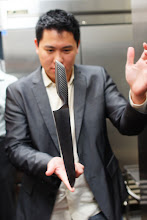
9 comments:
Love the presentation of the sashimi. Seems like a good price too for what you got!
How's it compare to the top places in LA?
I think it compares favorably. I'd probably rank it behind Urasawa and ahead of Mori. Zo has slightly better sushi, but it lacks the Kaiseki portion so overall I'd give the nod to Taro.
Just because someone has a license from the State to prepare Fugu, it does not immediately follow that they are incapable of error. The occasional deaths from eating it are proof of this. A little bit of faulty logic there!
I wasn't implying that a chef licensed to serve fugu would be infallible. Though I would certainly argue that a chef who has gone through the 2-3 year apprenticeship and passed the test to obtain a license is less likely to make a mistake.
Regardless, none of this applies to fugu in this case since the poison is removed before the fish is brought stateside.
Nice pics and thanks for posting this. And yes...we definitely would've wished the fugu got ya. =P
How can you afford these epic meals so often? Does your company reimburse everything?
Sam,
No such luck... looks like you'll have to deal with me for a while yet.
David,
My company pays a fixed sum and I pay everything above that amount. I think I paid close to 1000 OOP for food this trip.
"If you told me a few years ago that I would have preference for different types of fish sperm I probably would have punched you" lol
and good to find another place serving tuna spinal fluid now that saison's prices have shot up. Beyond that, it just looked like a great kaiseki
Ryan, this post ultimately helped me decide to go to Sushi Taro over Kaz Sushi Bistro when I was in D.C. last month. Here's my review, if you're interested: http://theoffalo.com/2013/03/winter-omakase-counter-at-sushi-taro/
Post a Comment